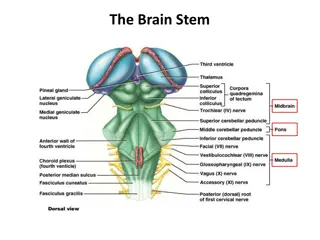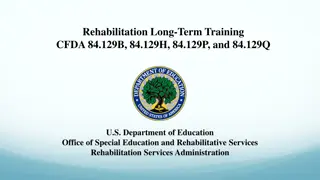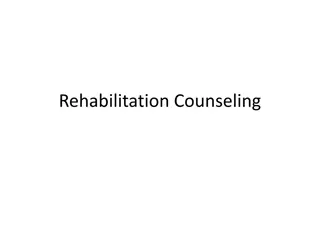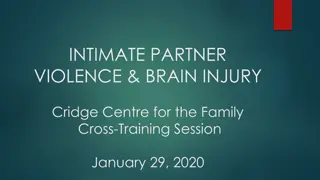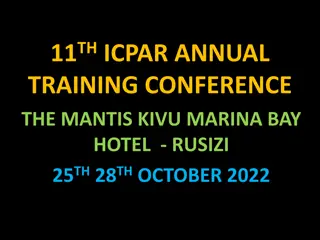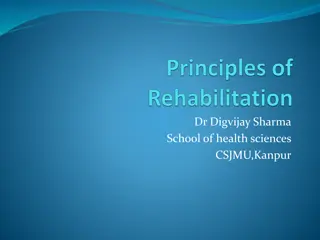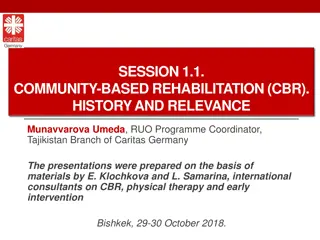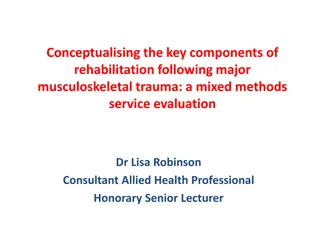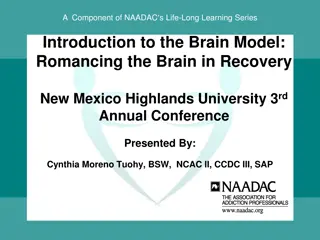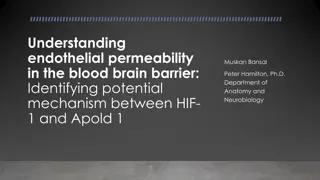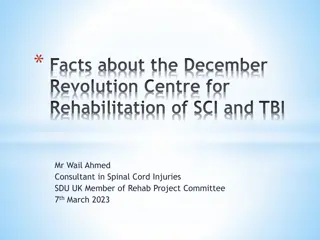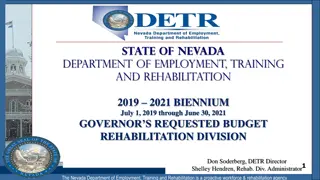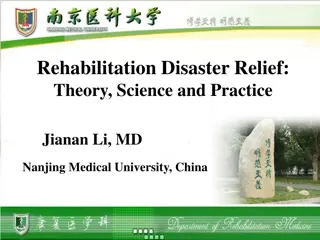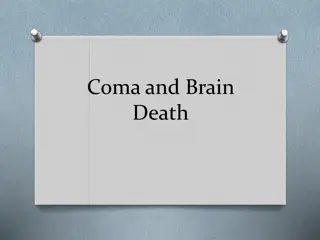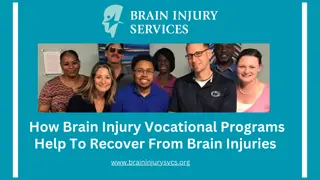Understanding Neuroplasticity: 10 Principles for Brain Rehabilitation
Explore the 10 principles of neuroplasticity for brain rehabilitation, including key concepts like "use it or lose it," specificity of exercises, and the importance of salience and intensity in therapy. Learn how practicing skills can strengthen neural connections and how therapists can help manage interference in skill development. Discover how these principles can help individuals recovering from brain injuries or strokes relearn skills and improve brain health.
Download Presentation

Please find below an Image/Link to download the presentation.
The content on the website is provided AS IS for your information and personal use only. It may not be sold, licensed, or shared on other websites without obtaining consent from the author. Download presentation by click this link. If you encounter any issues during the download, it is possible that the publisher has removed the file from their server.
E N D
Presentation Transcript
10 Principles of Neuroplasticity Aphasia-friendly toolkit Feb 2024 Disclaimer: These materials were created using funding from the Provincial Community Stroke Rehabilitation Initiative and crafted by Aran Oberle, Speech Language Pathologist, with input from regional rehab programs. They are not meant to replace professional expertise. Readers should seek advice from a qualified healthcare provider for any concerns. The content of this PowerPoint can be adjusted to suit the needs of healthcare professionals. Users are accountable for confirming the accuracy and suitability of the information for their unique situations.
10 Principles of Neuroplasticity NEUROPLASTICITY is the ability to heal and change the brain. It helps re-learn skills after a brain injury or stroke. There are 10 principles of neuroplasticity we use in brain rehabilitation therapy. 1. Use it or lose it 6. Interference 2. Use it and improve it 7. Time 3. Specificity 8. Age 4. Salience 9. Repetition 5. Transference 10. Intensity Adapted from: Kleim JA, Jones TA. Principles of experience-dependent neural plasticity: implications for rehabilitation after brain damage. J Speech Lang Hear Res. 2008 Feb;51(1):S225-39. doi: 10.1044/1092-4388(2008/018). PMID: 18230848.
10 Principles of Neuroplasticity 1. USE IT OR LOSE IT The brain has many neural connections of brain cells. Thoughts and actions use different connections in the brain. Brain connections only stay strongifthey re used. If you don t use them, they weaken and fade over time. 2. USE IT AND IMPROVE IT Practice makes brain connections stronger. Practice to keep brain strong. Adapted from: Kleim JA, Jones TA. Principles of experience-dependent neural plasticity: implications for rehabilitation after brain damage. J Speech Lang Hear Res. 2008 Feb;51(1):S225-39. doi: 10.1044/1092-4388(2008/018). PMID: 18230848.
10 Principles of Neuroplasticity 3. SPECIFICITY Brain cells perform specific actions and skills. Therapy exercises target specific brain cells and specific parts of the brain. Therapists use exercises that help specific parts of the brain. 4. SALIENCE Exercises should be meaningful to you. Research shows that motivation helps the brain heal. If you don't like the rehab program, ask the therapist for a different exercise. Adapted from: Kleim JA, Jones TA. Principles of experience-dependent neural plasticity: implications for rehabilitation after brain damage. J Speech Lang Hear Res. 2008 Feb;51(1):S225-39. doi: 10.1044/1092-4388(2008/018). PMID: 18230848.
10 Principles of Neuroplasticity 5. TRANSFERENCE Skills used in one situation can transfer to another situation. In therapy we practice skills to use in life outside therapy. 6. INTERFERENCE Practicing one skill can make other skills weak. Therapists know how to manage this. Adapted from: Kleim JA, Jones TA. Principles of experience-dependent neural plasticity: implications for rehabilitation after brain damage. J Speech Lang Hear Res. 2008 Feb;51(1):S225-39. doi: 10.1044/1092-4388(2008/018). PMID: 18230848.
10 Principles of Neuroplasticity 7. TIME Brain recovery has faster and slower periods of healing. It is normal to see different speeds or paces of healing. 8. AGE The brain learns more when young. Adults can also learn and re-learn things. Adapted from: Kleim JA, Jones TA. Principles of experience-dependent neural plasticity: implications for rehabilitation after brain damage. J Speech Lang Hear Res. 2008 Feb;51(1):S225-39. doi: 10.1044/1092-4388(2008/018). PMID: 18230848.
10 Principles of Neuroplasticity 9. REPETITION Practice practice practice! Train the brain often like you would train muscles. Repeat, consistent practice is important. 10. INTENSITY Intensity is how hard you are working. Intensity may be: number of times you do an exercise - how long you do the exercise - how difficult the exercise is - Changing intensity can keep homework interesting. Adapted from: Kleim JA, Jones TA. Principles of experience-dependent neural plasticity: implications for rehabilitation after brain damage. J Speech Lang Hear Res. 2008 Feb;51(1):S225-39. doi: 10.1044/1092-4388(2008/018). PMID: 18230848.
10 Principes de neuroplasticit La NEUROPLASTICIT est la capacit de gu rir et de changer le cerveau. Elle aide r apprendre les comp tences apr s une l sion c r brale ou un AVC. Il y a 10 principes de neuroplasticit qu'on utilise dans la th rapie de r habilitation du cerveau. 1. Utiliser ou perdre 6. Interf rence 2. Utilisez-le et am liorez-le 7. Temps 3. Sp cificit 8. ge 4. Saillance 9. R p tition 5. Transfert 10. Intensit Adapt de: Kleim JA, Jones TA. Principles of experience-dependent neural plasticity: implications for rehabilitation after brain damage. J Speech Lang Hear Res. 2008 Feb;51(1):S225-39. doi: 10.1044/1092-4388(2008/018). PMID: 18230848.
10 Principes de neuroplasticit 1. UTILISER OU PERDRE Le cerveau a de nombreuses connexions neuronales de cellules c r brales. Les pens es et les actions utilisent diff rentes connexions dans le cerveau. Les connexions c r brales ne restent solides que si elles sont utilis es. Si on ne les utilise pas, ils s affaiblissent et s estompent avec le temps. 2. UTILISEZ-LE ET AM LIOREZ-LE La pratique renforce les connexions c r brales. Pratiquez pour garder le cerveau fort. Adapt de: Kleim JA, Jones TA. Principles of experience-dependent neural plasticity: implications for rehabilitation after brain damage. J Speech Lang Hear Res. 2008 Feb;51(1):S225-39. doi: 10.1044/1092-4388(2008/018). PMID: 18230848.
10 Principes de neuroplasticit 3. SP CIFICIT Les cellules c r brales ex cutent des actions et des comp tences sp cifiques. Les exercices de th rapie ciblent des cellules du cerveau sp cifiques et des parties sp cifiques du cerveau. Les th rapeutes utilisent des exercices qui aident des parties sp cifiques du cerveau. 4. SIGNIFICANCE Les exercices devraient tre significatifs pour vous. La recherche montre que la motivation aide le cerveau gu rir. Si vous n aimez pas le programme de r adaptation, demandez au th rapeute un autre exercice. Adapt de: Kleim JA, Jones TA. Principles of experience-dependent neural plasticity: implications for rehabilitation after brain damage. J Speech Lang Hear Res. 2008 Feb;51(1):S225-39. doi: 10.1044/1092-4388(2008/018). PMID: 18230848.
10 Principes de neuroplasticit 5. TRANSFERT Les comp tences utilis es dans une situation peuvent tre transf r es dans une autre situation. En th rapie, on pratique les comp tences utiliser dans la vie en dehors de la th rapie. 6. INTERF RENCE La pratique de comp tences dans un domaine peut affecter d autres comp tences dans un autre domaine. Les th rapeutes savent comment g rer cela. Adapt de: Kleim JA, Jones TA. Principles of experience-dependent neural plasticity: implications for rehabilitation after brain damage. J Speech Lang Hear Res. 2008 Feb;51(1):S225-39. doi: 10.1044/1092-4388(2008/018). PMID: 18230848.
10 Principes de neuroplasticit 7. TEMPS La r cup ration c r brale a des p riodes de gu rison plus rapides et plus lentes. Il est normal de voir diff rentes vitesses de gu rison. 8. GE Le cerveau apprend plus quand il est jeune. Les adultes peuvent aussi apprendre et r apprendre des choses. Adapt de: Kleim JA, Jones TA. Principles of experience-dependent neural plasticity: implications for rehabilitation after brain damage. J Speech Lang Hear Res. 2008 Feb;51(1):S225-39. doi: 10.1044/1092-4388(2008/018). PMID: 18230848.
10 Principes de neuroplasticit 9. R P TITION Pratiquez pratiquez pratiquez! Entra nez le cerveau souvent comme vous entra neriez les muscles. La pratique r guli re est importante. 10. INTENSIT L intensit est la mesure du travail. L intensit peut tre : le nombre de fois que vous faites un exercice pendant combien de temps on fait l exercice la difficult de l exercice Changer d intensit peut rendre les devoirs int ressants. Adapt de: Kleim JA, Jones TA. Principles of experience-dependent neural plasticity: implications for rehabilitation after brain damage. J Speech Lang Hear Res. 2008 Feb;51(1):S225-39. doi: 10.1044/1092-4388(2008/018). PMID: 18230848.

























